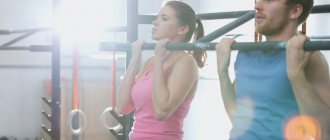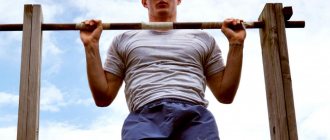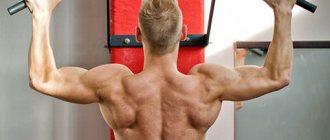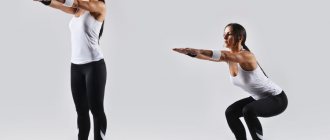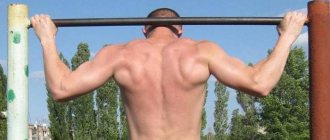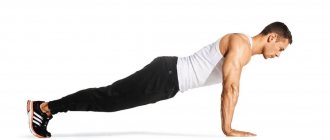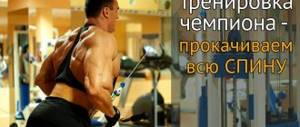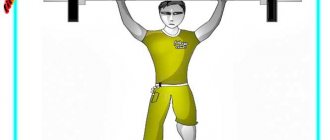What is a gravitron used for?
The Gravitron is a simulator that allows you to perform a pull-up exercise with less weight than your body. A good alternative for girls and those starting their journey in the gym. Great for a beginner's training program. Read the article on how to perform gravitron pull-ups and which grip to choose.
The target muscles in the exercise are the latissimus dorsi .
Gravitron wide grip pull-ups are the main exercise for the back when compared to other grips. Let's look at several options for pull-ups: wide grip, narrow, medium, partial and alternate pull-ups.
The principle of operation of the gravitron
The Gravitron is a multifunctional simulator. With its help, you can develop not only the back muscles, but also the triceps and biceps. The principle of its operation is quite simple and resembles a scale with two bowls. One of them is a moving platform on which the athlete is located, the other is blocks (weights). In the initial phase, the platform with the athlete weighs more, so it is at the bottom. But as soon as we start doing pull-ups, the situation changes; now the blocks are lowered down, raising the platform. The greater the weight of the weight, the easier it is to perform the exercise. There are some recommendations. It is best for beginning athletes to start performing pull-ups in a gravitron with 70% of their own weight. And then gradually select the one with which you can safely work. It turns out to be a slight paradox: the greater the weight of the weight, the easier it is to perform the exercise.
Gravitron pull-up: video
Pull-ups with counterweight technique
- Set the weight of the projectile that you want to compensate from your body. Grab the bar with a wide grip and stand with your feet on the support of the machine. Lower yourself until your arms are straightened. This will be the starting position.
- Exhale and pull yourself up to the chin position of the bar. Look ahead. Keep your elbows pointing down.
- Return to the starting position by exhaling. Repeat the movement 15 times.
Gravitron pull-up
Important ! The simulator is quite simple to learn, but there are several nuances. Step on the support of the machine carefully and lower it at the end without jerking, holding it with your foot. Don't jump straight to the floor. There are steps for descent.
Pros of pull-up exercises with a gravitron or counterweight
- The Gravitron allows girls or novice athletes to do pull-ups.
- A counterweight trainer allows you to practice your pull-up technique with any hand grip.
- It is one of the most popular exercise equipment in fitness clubs.
Of the minuses . The high height of the simulator can be a hindrance if a person is afraid of heights.
What muscles are used by gravitron pull-ups?
Performing back exercises is more aimed at developing the latissimus muscles.
Pull-ups in the gravitron were no exception. It is the lats that are responsible for bringing the arms to the body from a raised position. In addition to the main muscles, the following are involved:
- Diamond-shaped.
Small muscles located between the shoulder blades, responsible for their stabilization and reduction. - Trapezoid.
Namely its middle and lower parts. Helps the rhomboid muscles retract the shoulder blades. - Big round.
Together with the lats, it brings the arms to the body (performs a pulling movement). - Rotator cuff muscles.
Responsible for stabilizing the humerus and helping to rotate it. In the gravitron their role is much less than in classical pull-ups. - Biceps.
Many athletes perform pull-ups by bending their arms at the elbow joint, rather than bringing them toward the body. As a result, most of the load goes into the biceps. This technique for developing back muscles is ineffective. - Triceps.
Basically, this muscle plays a stabilizing role in pull-ups. But one of its heads, long, also helps the lats and brings the arms to the body. - Deltoid.
They are shoulder stabilizers. Depending on the grip, they will participate in the exercise with different activity. - Abdominal and pelvic muscles.
These muscles help stabilize the torso.
Exercises on the simulator
The exercise machine is multifunctional and allows you to strengthen almost all muscle groups.
Let's take a closer look at the most popular exercises: gravitron push-ups and gravitron pull-ups. The technique of performing pull-ups is determined by the type of grip of the hands on the crossbar (handles) of the structure and includes the following general steps:
- Depending on your preparedness and planned training scheme, we install a counterweight. The heavier it is, the less stress on the muscles.
- Using steps, we sit on a movable platform either with emphasis on our knees or feet (depending on the type of structure).
- We grab the bar with the required grip. Straighten your back, look forward in front of you. We breathe evenly and deeply.
Now we are ready to perform pull-ups on the gravitron. As examples, consider several types of hand placement on the crossbar.
Wide straight open grip
Wide - arms wider than shoulders straight - palms facing away from us open - thumb along with the rest are above the crossbar grip is optimal for improving the structure of the upper part of the latissimus, teres major and trapezius muscles.
During pull-ups, you need to squeeze your shoulder blades together as much as possible and try to reach the bar with your chest. The biceps remain relaxed.
Narrow straight closed grip
Narrow - we place our hands next to each other; straight, closed - with thumbs at the bottom of the bar; the grip helps effectively pump the shoulder, lower part of the latissimus and serratus muscles.
Narrow reverse open grip
This hand position (with a reverse grip, palms facing us) is used to train the lower lats and biceps. When performing the exercise, it is recommended to move your shoulders back and, tensing these muscles, touch the bar with your upper chest.
By analogy, you can use various variations of hand placement for pulling up in a gravitron. The technique of performing the exercise implies adherence to the following general principles:
- Bending the arms and reaching the highest point is done while exhaling, returning to the starting position while inhaling.
- In the upper position, you should take a short pause (2-3 seconds).
- Movements should be made smoothly. Up - at a faster speed than returning to the starting position.
- At the bottom point, leave your arms slightly bent and avoid delays.
- During the exercise, the back is straight, the gaze is directed forward.
Push-ups on a gravitron
The starting position for doing push-ups is similar to that described for pulling up. The only difference is that in this case we take the bars with a grip no less than shoulder width apart. The arms are bent at an angle not exceeding 90 degrees. The upward movement is carried out intensively and while exhaling, downward - smoothly and while inhaling. At the highest point, your shoulders should be pulled back. The main load falls on the trapezius muscles and triceps. The chest muscles are also improved. Exercise helps build a powerful torso.
It should be remembered that in order to achieve the expected results, classes need to be systematized. A training program with a determination of the number of approaches and repetitions must be drawn up separately, depending on the abilities and wishes of the student.
Unfortunately, not everyone has the opportunity to use this wonderful simulator. After all, not all gyms have it, and the equipment is quite cumbersome to install at home. It is impossible to replace pull-ups in a gravitron. Typically, a counterweight is imitated by using cords passed under the knees and secured at the ends to the crossbar with the required tension. As an alternative, equipment with a load-adjustable top link can also be considered. However, the effectiveness of the listed substitutes is significantly inferior to the gravitron.
The Gravitron is a worthy representative of the family of simulators available on the modern sports equipment market. It has earned particular popularity due to its versatility and safety. When used, developing strength and creating a beautiful, balanced figure becomes possible for people of different ages and physical fitness.
Benefits of this exercise
- Pull-ups in the gravitron help novice athletes and girls become familiar with the PULL-UP technique. After mastering it, you can gradually move on to the crossbar.
- Reducing the risk of injury to the rotator cuff muscles. In the gravitron, the body is fixed, unlike classic pull-ups, so it does not need constant stabilization. Consequently, the rotator cuff muscles experience less stress, as do the deltoids.
- The ability to perform pull-ups with more correct technique, even when the back muscles have almost reached their potential. This is one of the reasons why professional athletes sometimes resort to working in a gravitron.
- Opportunity to work in the eccentric phase. At the moment of lowering the weight, the muscles are much stronger. Therefore, you can see how professional athletes often use this technique in their training. For example, with the help of a partner, they squeeze the barbell in a BENCH PRESS and then slowly try to lower it down. Or with cheating they perform ARM BENDING, and then, straining the biceps, slowly straighten them. Of course, you can pull yourself up while swinging while working on the bar, but you may no longer have the strength to slowly straighten your arms.
- Greater variety of grips, which will allow you to more fully work out your back muscles and biceps.
- Strengthen target muscles and grip strength. This makes it possible to increase weights in more complex basic exercises.
- Pull-ups in the gravitron improve posture. This is especially true for athletes who use a large number of exercises in their training that create a compression load on the spine. These include: SPRINGS, SQUATS WITH A BAR, OVERHEAD PRESS.
- Formation of a V-shaped silhouette due to the development of the latissimus and teres major muscles.
Graviton simulator Personal experience of use
Hello! You've probably heard about such a simulator, and some of you have even seen it and trained on it. For those who are not familiar with this device, I note that its main task is to reduce the resistance arising under the influence of gravity, or gravitation, as the name of the device implies, which falls on the athlete while performing any exercise with his own body weight. In other words, this simulator seems to reduce its own body weight. While doing the exercise, you need to stand with your feet or knees, depending on the type of simulator, on special racks, on which the entire body weight will be placed.
The more weight is installed on this simulator, the lighter the weight of the person exercising on it will be. So, I personally use this machine to train almost all the muscles of the core. Typically, this list includes pull-ups, triceps dips, and pectoral dips. During training on this device, muscle groups such as the latissimus dorsi, trapezius, rhomboids, etc. pectoralis major, triceps, biceps, deltoids, and partly the abs are used. Basically, in my training practice, graviton is needed in order to create maximum development for the trained muscle groups.
Naturally, the body cannot tolerate such a stress load for a long time, so I use this training method occasionally. This is basically the moment in your training life when you feel energized. Of course, its arrival cannot be predicted, and it is not necessary. It is better to learn intuitive training than to try to know the incomprehensible. One day, for example, after a more or less uniform period of growth in results, I suddenly felt that in this workout I could perform a very large training volume. The target muscles for that day were the back and biceps.
As usual, I started doing the strength part of the workout with regular pull-ups on the bar, and when I reached the final approach, when I could no longer master the horizontal bar even for 6 repetitions, I switched to graviton. The first thing I did was set the weight to about a quarter of my own. I was able to do about 10 reps with this weight. After a two-minute rest, I set the weight to half my own and did another set. This time I managed to complete 12 repetitions. After a short rest, another approach followed, which already consisted of 9 repetitions.
The final set of graviton pull-ups consisted of 10 reps with three-quarters of my own weight. I note that the rest time between approaches did not exceed more than 2 minutes from the moment the strength part of the training began. After a set of pull-ups that took about 20 minutes total, I completed 5 sets of pyramid-style bent-over barbell rows and my back workout was complete. Next came a biceps workout, which I usually start with barbell curls. But on this day I decided to start with close-grip pull-ups.
Naturally, the back muscles are also involved in this exercise, but since they were previously “killed,” the entire load during the movement fell exclusively on the biceps. I started the first set with half my body weight, and finished four sets later with about 80% of my body weight. After that, I did dumbbell curls while sitting on a bench with emphasis on the inclined back. Thus, for the total training time, which was about 70 minutes, I completed almost double the amount of work. By completing such training, I know for sure that they will not happen again for at least the next 10 to 14 days.
Execution technique
To obtain results from performing pull-ups, technique plays a dominant role. Only after mastering it can you gradually reduce the weight of the burden. Before we begin to consider it, it is worth considering one point, namely the grip options that we can use in our training.
Grip options
- Medium grip.
Is classic. When using a medium grip, your hands should be slightly wider than shoulder-width apart. The best way to master pull-ups is with this one. Using a medium grip helps to engage not only the back muscles, but also the biceps and trapezius. This makes the movement itself a little easier. - Wide grip.
We place our hands at such a width that when they bend, a right angle is formed at the elbow joint. This grip allows you to reduce the load from the biceps and trapezius and transfer it to the upper sections of the lats. The teres major muscles will also work actively. When performing pull-ups with a wide grip, the range of motion will be short, so we can use much less weight. - Narrow grip (parallel).
Modern crossbars are equipped with special parallel handles located at a distance of 20-30 centimeters from each other. This position of the hands will shift the emphasis to the lower sections of the latissimus muscles, allowing the formation of the so-called “waist line”. The amplitude when using a narrow grip will be maximum. - Reverse grip.
Now we grab the bar from the back side (palms facing the face). Thanks to this, it becomes possible to move your elbows back behind your back and contract the latissimus muscles as much as possible. But due to the rotation of the forearms, the role of the biceps increases. And with poor neuromuscular connection, it can become the dominant muscle, taking most of the load onto itself. If you planned to use pull-ups to target the biceps muscle, then everything is fine. But when the goal is to develop the latissimus muscles, then you need to focus on bringing the shoulder blades together and bringing the arms to the body.
Performance:
- Set the required number of blocks. We stand in the middle of the platform, or place our knees on a soft pillow.
- We take the selected grip on the crossbar. With medium and wide arms, the elbows will look to the sides. If we use a narrow or reverse grip, then we bring them forward.
- The back is straight, the gluteal muscles and abs are tense.
- As you exhale, we lift ourselves up by contracting the latissimus muscles. Pull yourself up until the bar is level with your chin. We take a short break at the top point.
- Then, as you exhale, slowly and under control we lower ourselves to the starting position.
Recommendations for implementation
- Perform the movement slowly and under control. At the top point, be sure to pause without pain in order to squeeze the latissimus muscles as much as possible.
- Do not round your back while doing the exercise. Not only will this take stress off the target muscles, but it can also cause spinal injury.
- Don't push your pelvis back. The gluteal muscles should be in static tension, just like the abs.
- We focus on bringing the arms towards the body, rather than bending them at the elbow joint.
- Stretch your back muscles as much as possible at the bottom, unless of course you are doing partial pull-ups.
- Do not help yourself in lifting your torso. Gravitron is designed for clean execution without cheating.
- After completion, carefully descend from the machine along the special steps. No need to jump off it!
Useful tips
The benefits of practicing on a graviton manifest themselves under conditions of its proper use.
Using the simulator is correct if you:
- keep your back straight;
- Having risen to the set level, fix the position for a couple of seconds;
- rise with a jerk, fall down carefully.
- remember that the higher the weight is set, the less lifting of your own weight;
- don’t get hung up on one grip;
- breathe correctly: as you exhale, lift, while inhaling, extend your arms.
Tips for maximum efficiency
- Before starting your workout, be sure to complete a set of WARM-UP EXERCISES. Pay special attention to the elbow and shoulder joints.
- If there is no gravitron in the hall, you can replace it with a rubber expander or tourniquet. To perform this, you need to secure the upper edge to the crossbar, and rest your foot or knee on the lower edge. It is very important, before you start doing pull-ups, to make sure that the expander does not come off and fly into your face.
- Athletes with weak hands can use special straps to make it easier to stay on the bar. Over time, it is worth paying attention to strengthening your forearms. Rope pull-ups are best suited for this role.
- In exercises aimed at developing the latissimus muscles, it is best to use an open grip (the thumb does not wrap around the bar). This will reduce the activity of the biceps.
As you can see, pull-ups take place in the gravitron. Without it, the process of learning this movement could be delayed. Also, the majority of those who want to develop the latissimus muscles would have to be content with the VERTICAL PULL. Yes, this exercise also effectively affects the latissimus muscles, but is still inferior to pull-ups.
Good luck to everyone in your training!
Exercises for the chest in the gravitron
To develop the thoracic region, push-ups are used. This same exercise, slightly modified, helps strengthen the triceps muscles. The gravitron has special handrails that imitate bars.
Step-by-step technique for performing push-ups in a gravitron:
- Set the required resistance in the fitness equipment.
- Stand on the steps. Grasp the parallel handrails with straight arms, placing your palms under your shoulder joints.
- Rest your knees on the platform.
- Inhaling, bend your elbows and gently lower yourself down with the moving platform.
- With your elbows bent at right angles, stop for 1-2 seconds. Do not spread your elbows to the sides.
- Using your pectoral muscles and triceps, lift yourself up into the starting position.
- Do the prescribed number of repetitions.
- Take your knees off the platform one by one and step down onto the steps.
If the bars are spaced widely, the pectoral muscles are well trained. On narrow parallel bars, the triceps work actively. Unfortunately, not all machines allow you to change the width of your grip in push-ups.
What types of gravitrons are there?
There are 4 types of counterweight trainer:
- For pull-ups.
- For push-ups.
- Complex.
- With or without the ability to change weight (cast, solid counterweights).
Typically, cast counterweights separately for push-ups or pull-ups are located on the street near cultural and recreation parks, next to sports fields or on their territory. The counterweight there is solid, so it is not possible to get a good load.
This is a good option as a warm-up. You can do 20–30 repetitions without warming up. Even those who cannot do pull-ups or push-ups will be able to perform at least 10 repetitions without much difficulty.
A counterweight at the end of a workout will be very useful to finish off already tired muscles. It is quite difficult to perform full pull-ups at such moments - the muscles are very tired and there is little strength. A counterweight solves this problem. So, this machine is suitable for both beginners and experienced bodybuilders. However, you can’t place it at home - it’s too big.
Lead-up exercises
So, in order to learn how to do pull-ups on the horizontal bar, you first need to master the lead-up exercises.
Strengthen your grip
In one of the previous posts we looked at ways to develop grip strength. The stronger your hands, the easier it is for you to do pull-ups. You can use hanging on the horizontal bar for a while to strengthen your grip.
"Negative hang"
The idea is that the exercise begins in the upper phase, when the bar is under the chin.
To do this, use an elevation to get to the starting position. Grasp the bar with your hands shoulder-width apart. It is better to tuck your legs towards your chest, engaging your abdominal muscles. Then begin to descend as slowly as possible. Under no circumstances should you suddenly jump to the ground! This way you risk damaging your intervertebral discs. The optimal number of repetitions for a beginner is three to seven in one approach. The number of approaches is about three, the break between approaches is a minute.
Is it possible to do pull-ups every day?
You shouldn’t overdo it, you need to give the muscle a rest, so the optimal training frequency is two to three times a week.
Upper pulley to chest
Another exercise for mastering pull-ups is the lat pull-down. The fact is that most beginners, when learning to do pull-ups, make the mistake of trying to “pull” their body up using the strength of their arms.
Key points of the execution technique: hand position - the entire palm (including the thumb) lies on the bar on top, arms wide;
The shoulder blades should be slightly brought together (without touching),
shoulders slumped slightly
Performing any vertical thrusts is divided into several phases. First, you must pull the bar down with the strength of your shoulders and triceps (to about the middle of the trajectory), without bending your elbows; then, when the bar is just above your head, you should feel the latissimus dorsi muscles activate and consciously engage them in the exercise. By bringing the weight up to your chin, you bring your shoulder blades together.
As you perform the overhead row, gently pull the weight down toward your chin, focusing on engaging your back muscles and drawing your shoulder blades toward each other. Hold the position at the bottom point for a second or two, then carefully return the bar to its starting position, without losing control of the weight. Under no circumstances pull the bar by your head, this is a serious mistake!
Pull-ups with expander.
Thanks to the expander, you can significantly increase the number of repetitions of each exercise - and thus work the involved muscle groups more intensively. Similar exercise machines are available at any sports store. As a last resort, you can make such an elastic band yourself from a medical tourniquet, but this is not so effective.
Exercise with a partner
The partner stands behind you and, at the moment when you rise, slightly pushes your body up and thus relieves the load at the moment of greatest tension.
Statics
Another way to strengthen your arms is to hold at the top for as long as possible on your last set and then slowly lower down. This develops tendons and joints, which is very important in pull-ups. Static exercises should be a mandatory part of your training.
Back muscle stretching
After performing pull-ups or lifting exercises, it is a good idea to stretch the working muscles. This will improve the recovery process and the effect of the exercise.
Learning to do pull-ups at home
If you want to install a horizontal bar at home, to perform the exercise correctly you will need a fairly wide crossbar, secured as stably as possible. It is important to take into account the space above the horizontal bar, otherwise you will constantly think about how not to hurt your head on the ceiling or doorway.
How often to exercise
As with any other mass and strength exercise, it doesn't make sense to push yourself and pull yourself up every day. You need to let the muscle recover. Therefore, three times a week is the optimal frequency for training progress. It is better to include pull-ups in combination with other exercises, this will increase the release of testosterone, the growth hormone, and speed up the results. If your goal is local endurance, you must perform additional exercises. For this purpose, it is worth using parallel bars, which are available in almost every yard, or performing the most common push-ups from the floor, strengthening the biceps, triceps and latissimus dorsi muscles. If your goal is fat burning and general physical performance, then add exercises for other muscles, abs and legs, then the result will not be long in coming.
Source
Triceps push-ups
Push-ups are simple and accessible to every person, since absolutely no additional tools are required to perform them. But, this program does not provide the opportunity to build large muscle mass. Because a person only uses his own body.
Push-ups at home will become indispensable for those people who missed a planned workout, but still want to keep their body in good shape.
At home using dumbbells
It’s possible to pump up your triceps at home. At the same time, they use not only basic exercises, but also limited movements, which must be repeated at the end of the lesson. This must be done to completely exhaust the muscles in order to get a pumping effect as a result.
There are several exercises that are very popular among athletes, namely:
- when bending over, straighten your arms to the triceps;
- straighten the limb with a dumbbell from behind the head;
- straighten your arms with dumbbells, having first taken a lying position.
A person who wants to build muscle mass must remember that the entire workout should be built with an emphasis on these exercises. Because they are the most effective in achieving the task. You can pump up large triceps at home if you follow a few rules, namely:
- exercise regularly;
- perform the base;
- monitor proper nutrition;
As you can see from everything described above, it is quite possible to pump up big arms at home, the main thing is to regularly train.
Conclusion
You can enlarge your arms or correct your own body using many methods, and almost all of them are very effective. A person can get a positive result from this exercise only if he practices regularly. Almost all the methods by which the desired effect is achieved have been listed above.
And it doesn’t matter how the classes will be conducted, at home or in the gym under the supervision of a trainer, the main thing is the desire of the person himself
Vertical thrust in a hummer
This exercise is similar to the previous one, but its peculiarity is that when the levers move along a stable path, the joints and spine do not receive too much load. Vertical rows are definitely something worth replacing pull-ups with.
Technique:
- Pre-configure the machine for yourself by adjusting the seat height and setting the working weight.
- Sit down, rest your torso against the back of the machine. Bring your shoulder blades together, your back should be straight, and maintain a slight arch at the bottom. Keep your body motionless during the approach. Grab the levers of the machine with a narrow grip, elbows close to the body. Using a wide grip, your elbows should go out to the sides.
- Pull the levers towards you, synchronizing your breathing and movements. As you exhale, bring your shoulder blades together, fully opening your chest. Lift the levers with the strength of your latissimus muscles, moving your elbows as far back as possible.
- As you inhale, reverse the movement and carefully return the weight to the starting position. At the lowest point, maintain a slight angle in your elbow joints. Perform 10-15 repetitions.
What is a gravitron for?
How many gyms have we seen! Not everyone had a pull-up machine. Let's say more - not in every 3 or even 4 rooms.
Usually, instead of such a simulator, rubber bands are used, which support the knees during push-ups on the uneven bars and work on the horizontal bar.
This is a very large-sized rarity (therefore, a gravitron is inconvenient for the home), up to 2.5 meters high. If you nevertheless decide to place it at home, then it is better to place it in the yard (of course, in your yard when you are the owner of a private house).
The gravitron is a simulator, on one side of which there is a horizontal bar and parallel bars, and on the other, a counterweight with the ability to change weights.
Thus, here you can perform both pull-ups and dips. The horizontal bar allows you to perform various elements of pull-ups - narrow, wide, medium grip. Here you can fully pump up your back muscles, triceps and chest with all the same exercises that are described for the classic horizontal bar and parallel bars.
The only difference between classic and working with a simulator is the compensation of your efforts. If when working on the horizontal bar you lift almost the weight of your body (your mass minus the weight of your forearms), then in the gravitron it is possible to reduce this load until it is completely zeroed out. You can set the counterweight to half your body weight, one third, and so on. Or you can use the entire body weight, but then the muscles will not receive any load at all.
Basic technical recommendations
You can do pull-ups with different grips, but not all grips are equally good and have different effects on the muscles. For example, in order to pump up your back as much as possible, you need to do pull-ups with a wide grip. With a narrow grip, the triceps are loaded more. It’s better to start with a medium grip, when the distance between the hands is equal to the distance between the shoulders.
On topic: Training schedule for wrestlers
Later, when you gain experience, you can master more complex types of grip.
Breath
Don’t hold your breath; you need to exhale as you ascend and push, and inhale smoothly as you descend.
Body position. Tempo and amplitude
When grasping the bars, you need to keep your shoulder blades down and your shoulder joint in its natural position. The back is in a natural state. Do the exercise without jerking, smoothly and under control. When lowering, we don’t “throw” our hands, the movement is slow. Do not hang on tendons and ligaments and do not spread your elbows to the end. This tactic will help you work your muscles correctly and avoid injury.
Try to rise only using the strength of your upper body, do not “help” with your legs, do not swing. All movements are controlled and uniform. Raising the body up and lowering it down must be done in the same rhythm.
Do not strive for a high pace or meet any standards for the number of pull-ups per minute. This doesn't make any sense. This can only loosen the joints and not put a meaningful load on the muscles.
Begin the movement by engaging your latissimus dorsi muscles rather than trying to bend your elbows. Pull your elbows and shoulder blades down.
